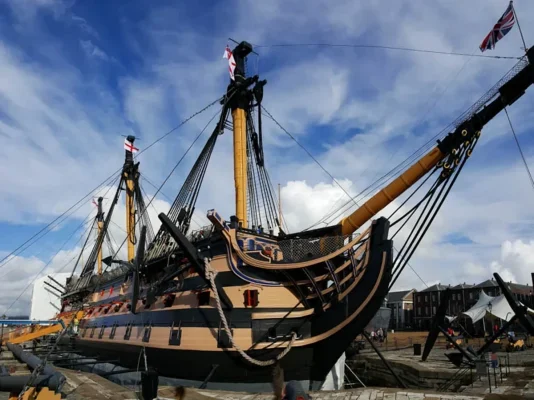 Pin
Pin It was the year of 1805, the year it seemed that at long last Napoleon would invade England, which, for twelve years, had stood in the path of the Grand Armée’s complete domination of Europe. It was the year when, in the face of all the evidence to the contrary, Napoleon had suddenly convinced himself that his united fleet could annihilate any squadron which the English could put to sea to meet it.
In August of 1805, he wrote to his admirals: “Come into the Channel. Bring our united fleet and England is ours. If you are only here for 24 hours, all will be over, and six centuries of shame and insult will be avenged.”
It was an order, however, which his captains found impossible to obey. Although Napoleon had 2,000 ships and 90,000 men assembled along the coast of France, the British blockade of the French and Spanish harbours had virtually immobilised this gigantic force.
In desperation, Napoleon ordered his fleet at Cadiz to sail out and meet the enemy ships which sat quietly waiting on the green Atlantic swells at Cape Trafalgar, some 80 kilometres east of Cadiz.
“His Majesty counts for nothing the loss of his ships,’’ Napoleon’s message ended, “provided they are lost with glory.”
In response to this order, a Franco-Spanish fleet of 33, with 2,640 guns, commanded by Admiral Villeneuve, set out from Cadiz to engage the enemy. Massive though this force was compared to the force that awaited them, its destruction was an almost foregone conclusion from the very beginning.
 Pin
Pin  Pin
Pin 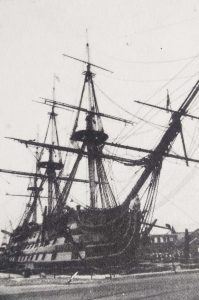 Pin
Pin 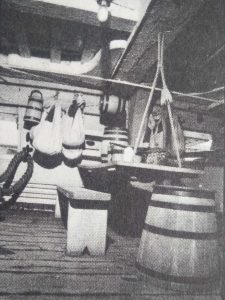 Pin
Pin The memory of England’s greatest sea battle after Drake’s defeat of the Spanish Armada is kept fresh in all our minds by the continued existence of HMS Victory, which is preserved in a dry dock at Portsmouth. Launched in 1765, she was already an old ship by the time of Trafalgar, which makes her survival to this day even more remarkable.
Walking her immaculate gun decks, shown in the picture below, it is difficult to imagine now just how terrible the conditions must have been for her crew, sweating over their belching guns, with the decks slippery with the blood of their dead or wounded comrades.
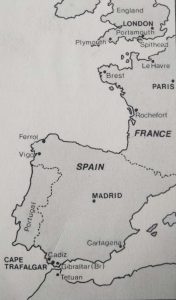 Pin
Pin There were several reasons for the inevitable destruction of the Franco-Spanish fleet, not the least being that it was commanded by a man who was haunted by the memory of his humiliating defeat at the hands of a much smaller English force only three months earlier. A man, moreover, that even Napoleon had decided at the last moment was ill-fitted for the task that had been entrusted to him.
As Villeneuve was sailing out of Cadiz, a horseman was hastening down the Spanish Peninsula, carrying a message, informing Villeneuve that he was to hand over his command to Admiral Rosily.
It would be wrong to assume that if the messenger had arrived in time to stop Villeneuve sailing, and the highly capable Admiral Rosily had been in command, the outcome of the Battle of Trafalgar might have been a different one. There were too many other factors weighed in the balance against the Franco-Spanish fleet for this to have happened.
Like Villeneuve, the captains of the French and Spanish fleets were imbued with a sense of impending defeat before they had even encountered the enemy. And with good cause!
Demoralised by a long period of inactivity, and with 1,700 sick men aboard their ships, the French sailed out of Cadiz knowing that only a miracle could give them a victory.
Press-ganged crews
The Spanish ships, manned mostly by soldiers or by beggars press-ganged from the slums of Cadiz, with gunners who had never fired a gun from a rolling ship, and commanded by Spanish captains who resented being placed under a French admiral, were in an even worse plight.
Most unnerving of all for the captains of the fleet was the knowledge that they were about to pit themselves against the most skilful sea captain of all time — Horatio Viscount Nelson.
Only slightly less awe-inspiring was the British Jack Tar himself, that clay-piped, pig-tailed sailor, who, more often than not, had been recruited by the press gangs from the scourings of the English sea towns. Already an aggressive fighting man by instinct, he had literally been whipped into becoming a magnificent sailor by the iron discipline of autocratic captains for whom the lash was the answer to almost every infringement of the ship’s rules.
A seasoned French sailor would have had difficulty in holding his own against such a formidable foe, let alone those pathetic crews sailing out to meet the English fleet.
On the 20th of October, 1805, the Franco-Spanish fleet was sighted, and soon afterwards the area where the British ships waited became bright with patches of gaudy bunting as each ship broke out strings of flags which passed on the message: “The French and Spanish are out at last, they outnumber us in ships and guns and men: we are on the eve of the greatest sea fight in history.”
On board the flagship, HMS Victory, the message had been delivered to the English commander, a slight, one-armed man, blind in one eye and shabbily dressed in a threadbare frock coat stained with sea salt, its gold lace tarnished to black flattened rags.
Battle plans
This slatternly-looking admiral was, of course, Lord Nelson, who received the news with the utmost calmness. And why not? His battle plans had already been made and communicated to all his captains. Those plans, he was convinced, would give him a swift victory.
Until the Battle of Trafalgar, the problem of how a fleet could gain an annihilating victory over the enemy was one that had never really been solved, and for want of a better tactic, it had been the custom for the fleets to sail into action in two parallel lines, with each ship taking on a single opponent, firing its guns broadside as it passed.
Inevitably, the enemy would take an opposite tack, and the battle would then become a vastly prolonged affair, with the ships continually sailing on opposite tacks, or engaging on the same tack, until one of the fleets eventually retired.
Nelson had decided to break completely with this tradition. His plan was to divide his fleet into two groups. One group would attack sections of the enemy line and destroy them before other ships could come to their aid. The other group would attack the enemy at right angles, break through their lines and then cut off the retreat of the enemy fleet.
This aggressive piece of strategy, which was later referred to as the ‘Nelson Touch’, was to change the whole course of naval warfare.
The battle did not begin until the following day, by which time the enemy fleet was well in sight, off Cape Trafalgar. Nelson was on deck, now in a freshly laundered uniform and with new ribbons for all the medals on his breast.
 Pin
Pin Above: The Victory’s main guns were 12 pounders (top) 24 pounders (middle) or 32 pounders.
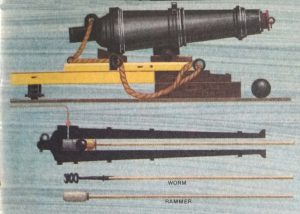 Pin
Pin The big , gun (above) was called a carronade; named. The Smasher. Once the powder hole had been, filled, it was fired by a slow match or flintlock. The cartridge and shot were laid by a rammer after the ‘worm’. had removed cartridge fragments, and the damp sponge had put out any sparks there might be in the barrel.
 Pin
Pin Above:
Top: A carrier for red hot cannon balls carried to the gunners.
Below: Various examples of the type of shot hurled at enemy ships.
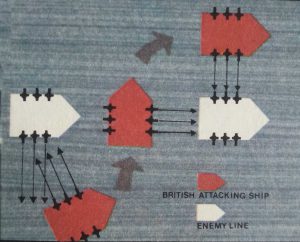 Pin
Pin Above: The raking manoeuvre employed with great success by the British ships. When attacking the enemy line, a British vessel would steer for a gap between enemy vessels. After brilliant seamanship had gained the British ship an advantageous position, a broadside was fired at one enemy vessel before sailing in front of it to unleash yet another broadside into the stern of the next ship in the line. Yet another broadside was then delivered to that crippled vessel from the other side.
 Pin
Pin Above: The first stage of the battle, with the Victory leading a frontal attack, while the rest of Nelson’s fleet attacks at right angles to break through the lines of the enemy ships, and thus cut off their retreat. This tactic was in complete variance with all the accepted rules of naval warfare. The last stage of the battle, with the French and English ships engaged in a general mêlée. By then 25 French ships were already out of action and trying to make for Cadiz.
Battle signal
Shortly after, Nelson called for the Signal officer. ‘‘Make the signal to bear down on the enemy in two lines,’’ he ordered. He then went down to make his will, which was witnessed by Captain Hardy and Captain Blackwood who had come aboard from the Euryalus. Afterwards, Nelson went up to the poop and ordered the signal officer to hoist his celebrated signal: ENGLAND EXPECTS THAT EVERY MAN WILL DO HIS DUTY.
 Pin
Pin Shown above is a naval captain of the period. The trumpet he is holding was used for shouting orders up to the mizzen mast. The buttons on the uniform were made of gilt brass with ‘roped’ edges.
It has been said that this famous signal was to have been worded: “Nelson confides that every man will do his duty,” and that his name was replaced by that of England at the suggestion of the signal officer, who pointed out that if the words ‘confides that’ were used, they would have to be spelt out with a long string of flags. The word ‘expects’ was substituted.
First blood
The first shot was fired at the English ship Royal Sovereign at noon. This salute of iron was received in Silence by the Royal Sovereign, who waited until she had drawn astern of the Spanish three-decker, Santa Anna, then raked her decks with a murderous fire that killed or wounded 400 of her crew.
In the meantime, Nelson’s ship was moving on, silent and intent, searching for the French admiral’s ship. Eventually, right in front of her, lay the huge Spanish four-decker, Santissima Trinidad. Guessing correctly that the French admiral’s ship must be nearby, Nelson bore down on her. As he did so, the Bucentaure, Villeneuve’s ship, and seven or eight other enemy ships, opened fire on the Victory. Still she advanced without firing. By the time she had come close enough to rake the Santissima Trinidad with her larboard guns, 50 of her men were dead and 30 wounded.
It was at this point that the Victory came into collision with the French Redoubtable. Locked together, and wrapped in sheets of flame, the two ships drifted slowly through the smoke of battle. Gradually, although the fighting had continued unabated, the smoke cleared a little from the decks of the Victory, enough for the marksmen to see the epaulets of the English officers. A marksman kneeling in the mizzen-top aimed his musket at Nelson.
On the quarterdeck of the Victory, Captain Hardy had turned to leave Nelson’s side to give an order when Nelson fell, mortally wounded. Immediately, Hardy, a sergeant of the marines and two privates, rushed forward to lift him up. Nelson was then carried down to the cockpit, where he ordered that his face should be covered with a handkerchief so that he might not be recognized.
In the meantime, the Redoubtable’s top marksmen had shot down 40 officers and men, destroying so many that the French, seeing the upper deck clear of all but dead or wounded, tried to board her. It was an enterprise which was to cost them dear. A boatswain’s whistle piped, “Boarders; repel Boarders’’, and the order immediately summoned swarms of smoke-begrimed blue-jackets to the deck, where they killed every man who had managed to board the Victory.
Below decks, Nelson’s life was now ebbing away fast. But he was still alive when Hardy returned from the fighting above to inform him that fourteen enemy vessels had given in. “That’s well,’’ Nelson said, “but I had bargained for twenty.’’ He lingered on for a little while longer. After murmuring some inarticulate words, he said distinctly, ‘‘I have done my duty. I thank God for it!”
Ruined dream
Above, beneath the setting sun, his fleet was lying in two groups with the shattered hulks of the enemy ships all around them. The British losses had been heavy; 449 killed and 1,241 wounded. But of the 27 ships of the British fleet, not one had been sunk or captured. Trafalgar was the decisive battle of the Napoleonic Wars.
It had always been essential to Napoleon’s master plan to control the world that he should have command of the seas. With his Allied fleet now ruined as a fighting force that dream had been destroyed forever.
Trafalgar, moreover, established England’s supremacy at sea for nearly a century and a half, during which time her navy remained the bedrock on which her control of the far-flung British Empire rested through the age of steam and into the 20th century.
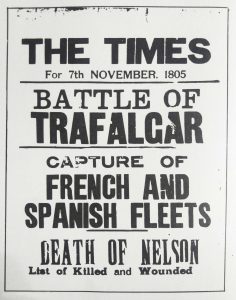 Pin
Pin It was not until several days after the battle that The Times newspaper was able to inform its readers of the outcome of the battle. Their joy that England had won a great sea battle was tempered by the knowledge that the country had lost its most beloved naval commander.
The Nelson Touch - Admiral Horatio Nelson
The Nelson Touch refers to the strategic brilliance and tactical skills exhibited by Admiral Horatio Nelson, one of the greatest naval commanders in British history. This term encapsulates Nelson’s unique ability to seize the initiative, inspire his men, and achieve victory against seemingly overwhelming odds. Nelson’s ingenuity and unconventional approach to warfare revolutionized naval tactics and had a profound impact on future generations of military commanders.
Admiral Nelson was born in 1758 in Burnham Thorpe, Norfolk, England, and joined the Navy at the age of 12. Through diligence and bravery, he quickly rose through the ranks and gained a reputation for his audacity and leadership skills. Nelson first showcased his tactical prowess in the Battle of Cape St. Vincent in 1797, where he successfully broke through the enemy line, effectively turning the tide of the battle in favor of the British. This maneuver, known as a “Nelson Touch,” involved the bold decision to disregard traditional naval formations and instead focus on targeting and engaging enemy ships directly.
However, it was in the Battle of Trafalgar in 1805 that Nelson’s strategic brilliance truly shone. Facing a combined fleet of French and Spanish ships, Nelson devised a plan that departed from conventional naval tactics. Instead of engaging the enemy in a line-by-line parallel formation, Nelson divided his force into two columns and attacked the enemy fleet head-on. By doing so, he aimed to overwhelm and confuse the enemy, preventing them from employing their superior numbers effectively.
At the heart of Nelson’s strategy lay his belief in the importance of unity and boldness. He once famously proclaimed, “No captain can do very wrong if he places his ship alongside that of the enemy.” This philosophy drove him to lead from the front, positioning his flagship, HMS Victory, at the forefront of the battle. By exposing himself to the greatest dangers, he inspired his men and instilled in them a sense of confidence and determination.
During the Battle of Trafalgar, Nelson’s unconventional approach proved highly effective. The two-pronged attack disrupted the enemy formation, creating chaos and confusion. Nelson’s flagship broke through the line, engaging the French Admiral Villeneuve’s ship, while the other column attacked from the rear. The British fleet inflicted devastating damage on the enemy, capturing or destroying 22 ships without losing a single vessel of their own.
Tragically, Nelson was mortally wounded during the battle when a sniper shot him from the rigging of a French ship. But even in his final moments, he continued to exert his leadership and conveyed his invaluable final order: “England expects that every man will do his duty.” This rallying cry encapsulates the essence of the Nelson Touch – the ability to inspire and motivate his men to perform acts of exceptional bravery and determination.
The Battle of Trafalgar demonstrated the effectiveness of Nelson’s tactics and solidified his status as a military genius. His innovative techniques, such as the strategic use of columns and the emphasis on individual initiative, influenced naval warfare for years to come. Moreover, his inspirational leadership and unwavering dedication to duty made him a revered figure among his sailors and earned him a lasting legacy as one of the greatest naval commanders in history.
The term “The Nelson Touch” perfectly encapsulates the strategic brilliance and visionary leadership of Admiral Horatio Nelson. His ability to seize the initiative, adapt to changing circumstances, and inspire his men in the face of adversity revolutionized naval warfare. His impact on military history cannot be understated, and his legacy continues to inspire military commanders to this day.
Admiral Lord Nelson employed several key strategies and tactics that contributed to his success in naval battles during the Napoleonic Wars. Some of these strategies and tactics include:
-
01
The Nelson Touch
Nelson had a unique ability to inspire and motivate his crew. He created a strong bond of loyalty and camaraderie by promoting a sense of unity, trust, and confidence among his sailors.
-
02
Speed and Initiative
Nelson emphasized the importance of speed and surprise in battle. He believed in taking bold and aggressive actions, often making unconventional decisions that caught his enemies off guard and disrupted their plans.
-
03
Concentration of Force
Nelson understood the significance of concentrating his forces to overpower the enemy. He aimed to bring superior firepower to bear on a smaller section of the enemy fleet, creating a numerical advantage in a particular area of the battle.
-
04
Superior Signals and Communication
Nelson implemented a sophisticated system of ship-to-ship signals, allowing for efficient communication and coordination during battles. This enabled him to keep track of his fleet and issue commands quickly, enhancing his tactical control.
-
05
Innovations in Tactics
Nelson introduced innovative tactics that deviated from the typical naval strategies of his time. He employed the “Nelson’s Cross,” a formation that focused on breaking through the enemy line, causing chaos and disarray, and isolating and overwhelming individual enemy ships.
CopiedInnovations in TacticsNelson introduced innovative tactics that deviated from the typical naval strategies of his time. He employed the "Nelson's Cross," a formation that focused on breaking through the enemy line, causing chaos and disarray, and isolating and overwhelming individual enemy ships.
-
06
Decisiveness and Audacity
Nelson was known for his decisive and audacious leadership. He often took risks and made split-second decisions based on his intuition and knowledge of naval tactics. This willingness to go on the offensive and seize the initiative gave him an edge over his adversaries.
CopiedDecisiveness and AudacityNelson was known for his decisive and audacious leadership. He often took risks and made split-second decisions based on his intuition and knowledge of naval tactics. This willingness to go on the offensive and seize the initiative gave him an edge over his adversaries.
-
07
Pre-Battle Reconnaissance
Nelson understood the importance of gathering intelligence on his enemy’s fleet and positions. He used skilled scouts and spies to gather information on the enemy’s strengths, weaknesses, and intentions, enabling him to formulate effective battle plans.
-
08
Inspirational Presence
Nelson led from the front and personally engaged with the enemy in battles. His courage and heroism were an inspiration to his sailors and created a sense of confidence and determination among his crew.
These strategies and tactics employed by Admiral Lord Nelson contributed to his remarkable success in naval battles during the Napoleonic Wars, ultimately solidifying his reputation as one of history’s greatest naval commanders.
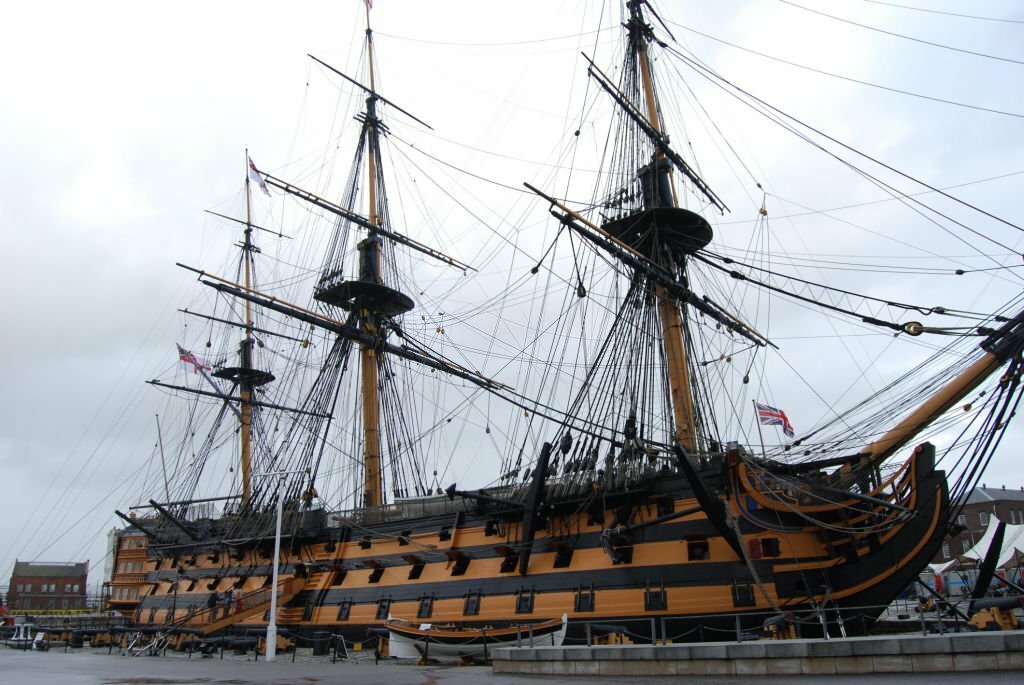 Pin
Pin The Battle of Trafalgar
One of the most famous battles where Admiral Nelson employed his innovative tactics and “The Nelson Touch” strategy was the Battle of Trafalgar in 1805. This battle took place during the Napoleonic Wars and resulted in a decisive victory for the British against the combined French and Spanish fleets.
Nelson’s strategy at Trafalgar revolved around breaking the traditional naval tactics of the time, which emphasized a linear approach to battle. Instead, he employed a bold plan that aimed to achieve a quick and decisive victory. Nelson divided his fleet into two columns and sailed directly at the enemy line, intending to punch through their formation and engage them in close-quarters combat.
During the battle, Nelson’s flagship, HMS Victory, was positioned in the center of the British fleet. Despite heavy enemy fire, he led his ship straight into the thick of the action, engaging multiple enemy vessels simultaneously. This created chaos and confusion among the opposing fleet, as they were not accustomed to such aggressive tactics.
The Nelson Touch strategy had a significant impact on the outcome of the Battle of Trafalgar. By splitting his fleet into two columns, Nelson was able to concentrate British firepower on a smaller portion of the enemy fleet, overwhelming their defenses. This divide-and-conquer approach effectively disrupted the enemy’s ability to coordinate a response.
Moreover, Nelson’s decision to engage the enemy at close range played a crucial role. The traditional tactics of the time focused on long-range artillery duels, but Nelson recognized the importance of close-quarters combat where British sailors’ superior gunnery and boarding skills could shine. This decision resulted in devastating damage to the opposing fleet and enabled the British to capture numerous enemy ships.
Although Nelson was tragically killed during the battle, his strategy and leadership left a lasting impact. The Battle of Trafalgar solidified British naval dominance, effectively ending Napoleon’s plans to invade Britain and securing British control over the seas for the next century. Nelson’s ability to innovate and implement unorthodox tactics showcased the effectiveness of that approach and set new standards for naval warfare.
It is worth noting that while the Battle of Trafalgar is the most famous example of “The Nelson Touch” strategy, Nelson employed similar tactics in other engagements throughout his career, consistently achieving success by challenging conventional naval warfare doctrines.
"The Nelson Touch" can be applied to modern military strategies and leadership techniques
Although Admiral Horatio Nelson was renowned for his naval tactics in the late 18th and early 19th centuries, his principles and strategies continue to have a significant impact on contemporary naval operations. Here are a few examples:
Nelson believed in taking bold and decisive actions to achieve victory. This principle remains relevant in modern military strategies. The concept of shock and awe, widely used in modern warfare, draws inspiration from Nelson’s approach.
Focus on Morale and Motivation
Nelson emphasized the importance of maintaining high morale and motivation among his troops. This concept is still crucial in modern military leadership. Leaders understand the need to inspire and motivate their troops, as it enhances overall effectiveness.
Nelson trusted his subordinate commanders and encouraged initiative. This approach is reflected in modern military doctrines that emphasize decentralized decision-making and trust in lower-level leaders.
Understanding the Enemy
Copied
Understanding the Enemy
Nelson focused on understanding his enemy's strengths, weaknesses, and intentions. This aspect remains vital in modern military operations. In-depth intelligence analysis, reconnaissance, and understanding the adversary's capabilities are key components in contemporary warfare.
Nelson focused on understanding his enemy's strengths, weaknesses, and intentions. This aspect remains vital in modern military operations. In-depth intelligence analysis, reconnaissance, and understanding the adversary's capabilities are key components in contemporary warfare.
Nelson focused on understanding his enemy’s strengths, weaknesses, and intentions. This aspect remains vital in modern military operations. In-depth intelligence analysis, reconnaissance, and understanding the adversary’s capabilities are key components in contemporary warfare.
Nelson’s operational flexibility is highly relevant in modern military strategies. His ability to adapt to changing circumstances and improvise tactics in the midst of battle serves as an inspiration for modern naval leaders.
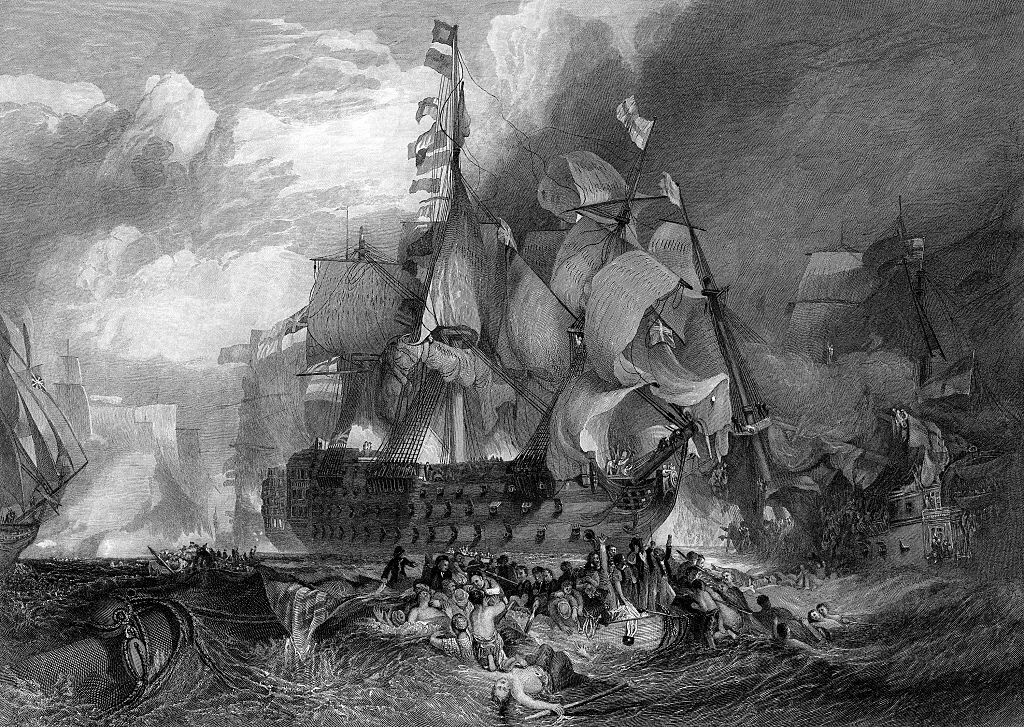 Pin
Pin These are some examples that showcase the influence of “The Nelson Touch” in contemporary naval operations. His principles still guide and inspire military strategists and leaders worldwide, allowing for the evolution of effective military strategies and leadership techniques.
Frequently Asked Questions : "The Nelson Touch"
“The Nelson Touch” refers to a term used to describe the leadership and strategic abilities of Admiral Horatio Nelson, one of Britain’s most renowned naval commanders during the Napoleonic Wars. It signifies his unique approach to naval warfare and his ability to inspire his fleet to victory against seemingly insurmountable odds.
“The Nelson Touch” is significant because it represents a set of leadership principles and strategies that are still studied and emulated by military leaders, business executives, and individuals aspiring to achieve success. Nelson’s innovative tactics, charisma, and ability to adapt to changing circumstances have made him an enduring figure in history.
Some of the key principles of “The Nelson Touch” include:
- Strong leadership: Nelson believed in leading from the front and building a personal connection with his subordinates. He gained their loyalty and trust through his humility and willingness to share their risks and rewards.
- Flexibility and adaptability: Nelson was known for his ability to quickly adapt to changing circumstances on the battlefield. He was decisive and not afraid to deviate from conventional tactics in order to gain an advantage.
- Clear communication: Nelson emphasized the importance of clear and concise communication to ensure that his orders were understood and executed without confusion. This helped maintain unity and discipline within his fleet.
- Boldness and calculated risk-taking: Nelson was not afraid to take calculated risks when he saw an opportunity for victory. He believed in seizing the initiative and striking the enemy with aggression to gain the upper hand.
Yes, “The Nelson Touch” principles can be applied outside of the military. Nelson’s leadership approach and strategic mindset have been adapted and applied in various fields like business, sports, and personal development. The emphasis on strong leadership, adaptability, clear communication, and calculated risk-taking can be beneficial in any competitive environment.
Absolutely. Despite the passage of time, the principles of “The Nelson Touch” remain relevant and continue to inspire leaders and individuals striving for success. The ability to adapt, communicate effectively, take calculated risks, and inspire those around you is timeless and valuable.
Yes, there are several books and resources available that delve into the leadership and strategies of Admiral Nelson. Some popular titles include “Nelson’s Way: Leadership Lessons from the Great Commander” by Stephanie Jones and Jonathan Gosling, “Nelson: The Sword of Albion” by John Sugden, and “The Signal and the Noise: The Art and Science of Prediction” by Nate Silver.
“The Nelson Touch” principles can be applied by anyone, regardless of their background or profession. While Nelson’s legacy is rooted in his naval career, his principles are universal and can be adapted to fit any context or situation where leadership, adaptability, communication, and calculated risk-taking are valued.
While “The Nelson Touch” originated in a military context, its principles extend beyond military success. Nelson’s leadership style and strategic thinking can be applied to various aspects of life, including personal growth, team management, and problem-solving in different environments.
While some elements of leadership and strategic thinking may come more naturally to some individuals, “The Nelson Touch” can be learned and developed through study, practice, and experience. Many successful leaders have emulated Nelson’s principles and achieved great success by applying them in their own fields.
The ultimate lesson from “The Nelson Touch” is to embrace a bold and adaptable approach to leadership and face challenges with confidence. By developing strong leadership skills, effective communication, and the ability to adjust strategies as needed, individuals can increase their chances of achieving success, just as Admiral Nelson did in his naval career.





























